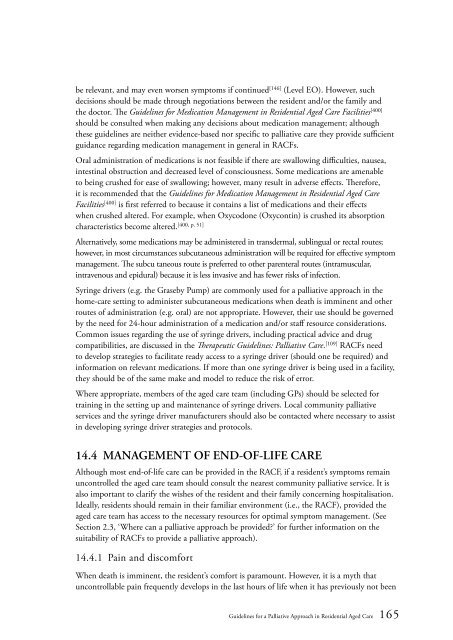Guidelines for a Palliative Approach in Residential Aged Care
Guidelines for a Palliative Approach in Residential Aged Care
Guidelines for a Palliative Approach in Residential Aged Care
Create successful ePaper yourself
Turn your PDF publications into a flip-book with our unique Google optimized e-Paper software.
e relevant, and may even worsen symptoms if cont<strong>in</strong>ued [146] (Level EO). However, such<br />
decisions should be made through negotiations between the resident and/or the family and<br />
the doctor. The <strong>Guidel<strong>in</strong>es</strong> <strong>for</strong> Medication Management <strong>in</strong> <strong>Residential</strong> <strong>Aged</strong> <strong>Care</strong> Facilities [400]<br />
should be consulted when mak<strong>in</strong>g any decisions about medication management; although<br />
these guidel<strong>in</strong>es are neither evidence-based nor specific to palliative care they provide sufficient<br />
guidance regard<strong>in</strong>g medication management <strong>in</strong> general <strong>in</strong> RACFs.<br />
Oral adm<strong>in</strong>istration of medications is not feasible if there are swallow<strong>in</strong>g difficulties, nausea,<br />
<strong>in</strong>test<strong>in</strong>al obstruction and decreased level of consciousness. Some medications are amenable<br />
to be<strong>in</strong>g crushed <strong>for</strong> ease of swallow<strong>in</strong>g; however, many result <strong>in</strong> adverse effects. There<strong>for</strong>e,<br />
it is recommended that the <strong>Guidel<strong>in</strong>es</strong> <strong>for</strong> Medication Management <strong>in</strong> <strong>Residential</strong> <strong>Aged</strong> <strong>Care</strong><br />
Facilities [400] is first referred to because it conta<strong>in</strong>s a list of medications and their effects<br />
when crushed altered. For example, when Oxycodone (Oxycont<strong>in</strong>) is crushed its absorption<br />
characteristics become altered.<br />
[400, p. 51]<br />
Alternatively, some medications may be adm<strong>in</strong>istered <strong>in</strong> transdermal, subl<strong>in</strong>gual or rectal routes;<br />
however, <strong>in</strong> most circumstances subcutaneous adm<strong>in</strong>istration will be required <strong>for</strong> effective symptom<br />
management. The subcu taneous route is preferred to other parenteral routes (<strong>in</strong>tramuscular,<br />
<strong>in</strong>travenous and epidural) because it is less <strong>in</strong>vasive and has fewer risks of <strong>in</strong>fection.<br />
Syr<strong>in</strong>ge drivers (e.g. the Graseby Pump) are commonly used <strong>for</strong> a palliative approach <strong>in</strong> the<br />
home-care sett<strong>in</strong>g to adm<strong>in</strong>ister subcutaneous medications when death is imm<strong>in</strong>ent and other<br />
routes of adm<strong>in</strong>istration (e.g. oral) are not appropriate. However, their use should be governed<br />
by the need <strong>for</strong> 24-hour adm<strong>in</strong>istration of a medication and/or staff resource considerations.<br />
Common issues regard<strong>in</strong>g the use of syr<strong>in</strong>ge drivers, <strong>in</strong>clud<strong>in</strong>g practical advice and drug<br />
compatibilities, are discussed <strong>in</strong> the Therapeutic <strong>Guidel<strong>in</strong>es</strong>: <strong>Palliative</strong> <strong>Care</strong>. [109] RACFs need<br />
to develop strategies to facilitate ready access to a syr<strong>in</strong>ge driver (should one be required) and<br />
<strong>in</strong><strong>for</strong>mation on relevant medications. If more than one syr<strong>in</strong>ge driver is be<strong>in</strong>g used <strong>in</strong> a facility,<br />
they should be of the same make and model to reduce the risk of error.<br />
Where appropriate, members of the aged care team (<strong>in</strong>clud<strong>in</strong>g GPs) should be selected <strong>for</strong><br />
tra<strong>in</strong><strong>in</strong>g <strong>in</strong> the sett<strong>in</strong>g up and ma<strong>in</strong>tenance of syr<strong>in</strong>ge drivers. Local community palliative<br />
services and the syr<strong>in</strong>ge driver manufacturers should also be contacted where necessary to assist<br />
<strong>in</strong> develop<strong>in</strong>g syr<strong>in</strong>ge driver strategies and protocols.<br />
14.4 MANAGEMENT OF END-OF-LIFE CARE<br />
Although most end-of-life care can be provided <strong>in</strong> the RACF, if a resident’s symptoms rema<strong>in</strong><br />
uncontrolled the aged care team should consult the nearest community palliative service. It is<br />
also important to clarify the wishes of the resident and their family concern<strong>in</strong>g hospitalisation.<br />
Ideally, residents should rema<strong>in</strong> <strong>in</strong> their familiar environment (i.e., the RACF), provided the<br />
aged care team has access to the necessary resources <strong>for</strong> optimal symptom management. (See<br />
Section 2.3, ‘Where can a palliative approach be provided?’ <strong>for</strong> further <strong>in</strong><strong>for</strong>mation on the<br />
suitability of RACFs to provide a palliative approach).<br />
14.4.1 Pa<strong>in</strong> and discom<strong>for</strong>t<br />
When death is imm<strong>in</strong>ent, the resident’s com<strong>for</strong>t is paramount. However, it is a myth that<br />
uncontrollable pa<strong>in</strong> frequently develops <strong>in</strong> the last hours of life when it has previously not been<br />
<strong>Guidel<strong>in</strong>es</strong> <strong>for</strong> a <strong>Palliative</strong> <strong>Approach</strong> <strong>in</strong> <strong>Residential</strong> <strong>Aged</strong> <strong>Care</strong> 165
















